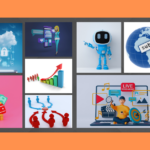The software as a service market size is poised for unprecedented expansion. It’s driven by a digital transformation supercharged by the global pandemic. Thanks to platforms like Zoom, VC in the space reached highs during this period, securing nearly $140 billion in funding in 2021 and 2022.
Publicly traded Thryv released numbers for Q1 2024, showing 30% client growth and 24% increased revenue over the last year.
But how are things shaping up for the future? The long haul. We asked our intern, CJ, also known as the “SaaS oracle”.
Here’s what he had to say: “What?”
We really need to find a better intern…
Now that the company fortune teller has let us down, let’s take a look at what’s happened, what’s currently happening, and what can possibly happen in the future.
Spoiler: It’s looking pretty good for startups as the Software as a Service market size continues to grow.
Table of Contents
Humble Beginnings to SaaS 2023
The Software as a Service market size was just $62 billion in 2016. Thanks mostly to the pandemic, that seems like a lifetime ago.
It has since more than quadrupled. For SaaS 2023, that number was more than $250 billion and is expected to be closer to $300 billion in 2024.
We’ve seen an annual growth rate averaging an impressive double-digit percentage for several years. The question is sustainability. Can it keep growing at this pace? The answer is no, of course not. Nothing can continuously grow at that kind of rate. But it will keep growing.
Why? There has been a shift in consumer behavior towards subscription-based services and a need for remote-friendly solutions.
This software industry segment has seen a revolution in the diversity and depth of services offered.
Cloud-based productivity tools. Customer relationship management (CRM) software. Enterprise resource planning (ERP) systems. These are just the beginning of a vast and varied ecosystem, with specialization and verticalization becoming the norm.
Factors Driving the Average SaaS Growth Rate
Multiple factors are steering the exponential average SaaS growth rate. Accessibility and convenience are chief among these.
The rise of mobile workforces further fuels this market. These employees and independent contractors need collaboration tools that work seamlessly across different locations and time zones.
Additionally, many SaaS applications’ scalability and customization features increase their appeal. They can easily accommodate a company’s growth or changes in workflow. SaaS products offer dynamic solutions that legacy systems cannot match.
Where the SaaS Market is Headed
Forecasts for the SaaS market size are staggering over the next eight years, and the numbers are eye-watering.
Analysts predict that the market will witness exponential growth. Some experts predict a 15% YOY growth rate and a market size hitting the trillion dollar mark over the next eight years.
This growth is expansive and global as developing economies increasingly adopt SaaS strategies to modernize their operations.
There has been a massive uptick in the proliferation of IoT devices and the integration of AI into SaaS products. We expect the next phase of growth will be marked by innovation and smarter, more intuitive services.
AI is without a doubt the “next big thing” for SaaS. In February 2024, the AI industry snatched up nearly $5 billion in VC capital. Yes, five billion. Yes, in one month. This equated to 20% of all VC funding for that month.
The SaaS marketplace will become more competitive as new players enter the game and existing ones evolve their offerings to retain and attract clientele.
Opportunities and Challenges Ahead
Opportunities in the SaaS market are abundant. The growing reliance on digital solutions creates a vast market for innovative products.
Additionally, the subscription model offers SaaS companies a steady, predictable revenue stream. It can be amplified through a relentless focus on customer retention and upselling.
But, with the rise in opportunities come challenges.
The SaaS market is becoming saturated. Standing out requires both a unique offering and a well-constructed B2B SaaS go-to-market strategy.
Furthermore, the subscription model necessitates unwavering customer satisfaction. A single bad experience can lead to customer churn, which is particularly damaging in this industry.
The Future Software as a Service Market Size and How to Prepare for It
The Software as a Service market size is robust and brimming with potential. SaaS 2023 showed us a continued and still impressive growth trajectory.
The average SaaS growth rate is driven by increasing digitalization, shifting towards remote work, and adopting cloud-based solutions.
Integrating AI will usher in a new era of innovation, further cementing the importance of SaaS in both the business world and our daily lives.
To succeed in a quickly saturating industry, focus on unique product offerings, deliver unparalleled user experiences, and implement effective market strategies. Check out this post for one of the best marketing solutions: hiring a fractional chief marketing officer.




